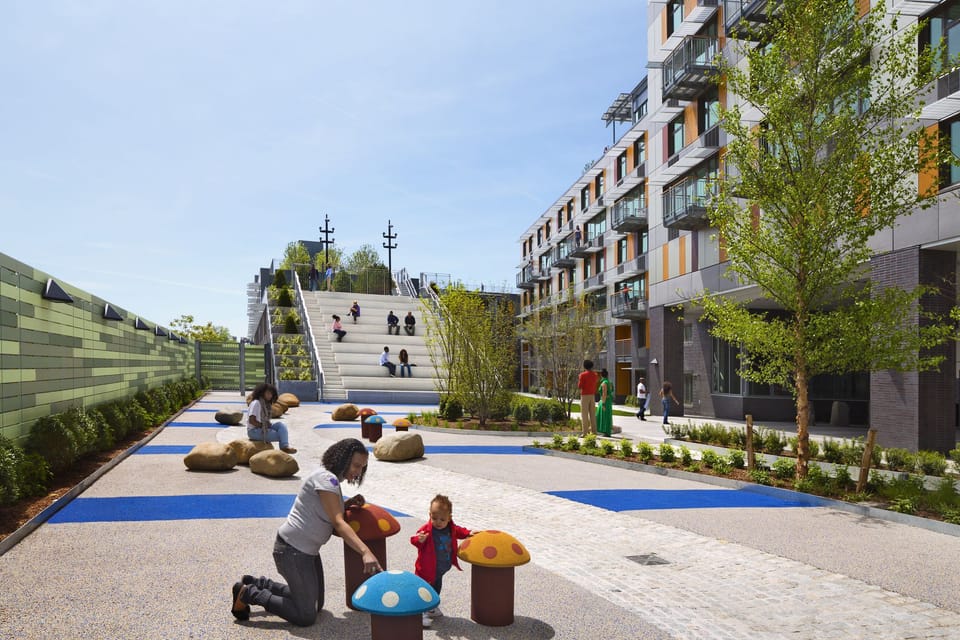Real Estate Developer: Agent of Social Change

What is real estate?
I think of homes, schools, office buildings, and planned communities—places that can propel growth and opportunity. Places to hang hats. I recently met a banker who offered a more succinct definition: Real estate is an investment vehicle for high-net-worth individuals.
Womp, womp.
Is this whole industry solely designed to generate more wealth for wealthy people? Historically, yes. But it can be so much more.
Money, Meet Mission
NOI, cap rate, IRR, equity multiple, cash-on-cash return. The viability and profitability of a project can more or less be determined by these five metrics. And every real estate model is built around them. While a project must fundamentally address a market need in order to hit these financial metrics, none of them speak to the experience of the people who will actually use the real estate.
Social impact real estate keeps investor metrics in place, but also targets social and environmental outcomes. In the U.S., the modern foundation for impact investing in real estate was laid in the 1960s and 70s with the rise of Community Development Corporations (CDCs) and Community Development Financial Institutions (CDFIs), which channel capital into disinvested, often low-income, neighborhoods. These organizations were a direct response to the social activism and civil rights movement of the time. The Community Reinvestment Act (CRA) then passed in 1977, obliging banks to actively reinvest in the communities where they operate, particularly low- and moderate-income (LMI) neighborhoods that suffered historical discriminatory lending practices like redlining. Organizations like LISC (founded in 1979) and Enterprise Community Partners (1982) pioneered models that combined affordable housing, community ownership, and social services—blending financial return with measurable community benefit. By the 1990s, this approach gained traction through federal tools like the Low-Income Housing Tax Credit (LIHTC), which helped scale mission-driven development. ESG (Environmental, Social, and Governance) investing came onto the scene in 2004 and the term “impact investing” itself wasn’t coined until 2007 at a Rockefeller Foundation convening. Despite the recent adoption of these terms, real estate is and always was a natural fit for the concept: it’s local, tangible, and tied to long-term outcomes like housing stability, health, and economic mobility.
Since the early 2000s, capital committed to impact investing has grown exponentially, surpassing $1.5 trillion globally in 2024, and its tenets have become central to many mainstream real estate funds. Today’s leading impact investors and developers like Goldman Sachs’ Urban Investment Group (big bank), The Community Builders (nonprofit developer), and MSquared (purpose-built platform) focus on low- and mixed-income housing, green building, and wraparound amenities such as education centers, job training hubs, and healthcare facilities, demonstrating that real estate can be a powerful agent for equity and systemic change.
A Couple of Case Studies
Jonathan Rose Companies
Jonathan Rose is a pioneering figure in social impact real estate, known for integrating affordable housing, environmental sustainability, and community well-being into large-scale urban development. Through his firm, Jonathan Rose Companies, he has developed and preserved tens of thousands of affordable and mixed-income housing units across the United States, often incorporating green building practices and on-site social services. Rose's projects are grounded in the belief that housing should be a “platform for opportunity,” providing residents not just with shelter but with access to education, healthcare, transit, and nature. Signature developments like Via Verde in the Bronx demonstrate how mission-driven real estate, designed and executed well, can hit financial metrics while advancing equity, quality of life, and climate resilience. Jonathan’s success and proof of repeatability have helped shift the industry conversation toward a more holistic and values-driven approach to urban development.
Via Verde by Phipps Houses and Jonathan Rose Companies
The Integral Group
The Integral Group, an Atlanta-based developer founded by Egbert Perry, is a national leader in transformational urban redevelopment, known for its pioneering work in creating mixed-income communities that blend market-rate, workforce, and affordable housing. Its most influential project, the revitalization of Atlanta’s East Lake neighborhood in partnership with the East Lake Foundation, transformed a public housing development into a thriving, mixed-income neighborhood centered on cradle-to-college education, accessible healthcare, and employment pathways. Fifteen years after redevelopment, the neighborhood saw violent crime drop by 95%, and its new school, Drew Charter School, ranked #1 among all public elementary schools in Atlanta. The project demonstrates that when housing is integrated with investment in schools and community services, entire neighborhoods can be lifted out of poverty. East Lake’s success inspired the launch of Purpose Built Communities, a national nonprofit currently supporting more than 25 neighborhoods in replicating this framework.
An aerial view of the East Lake neighborhood in Atlanta, GA
Building On The Shoulders of Giants
Once a project is built, ongoing impact measurement is critical to proving that the buildings achieve their intended outcomes over the long term. Via Verde is considered an overall success and has won many awards including the Urban Land Institute Global Award for Excellence and the AIA Housing Award, but even for a development of that magnitude ($99 million), post-occupancy impact evaluation has been fairly light, limited to anecdotal feedback from residents. East Lake has been studied to a greater degree, but while initial and even medium-term outcomes were dramatically positive, the long-term story is more mixed. For us, this points to the importance of measuring not just what matters, but who matters, and learning from our predecessors.
Rekindle will bring significant focus to long-term impact outcomes. We believe that multigenerational living will ease the unprecedented social, emotional and financial burdens affecting Americans today. To assess this impact, we are considering Harvard University’s human flourishing measure based around six domains: happiness and life satisfaction, mental and physical health, meaning and purpose, character and virtue, close social relationships, and financial and material stability. This measure underpins The Global Flourishing Study (GFS), a $43.4 million longitudinal research study and collaboration between scholars at the Human Flourishing Program at Harvard and Baylor’s Institute for Studies of Religion, and in partnership with Gallup and the Center for Open Science. The study involves over 200,000 participants from 22 geographically and culturally diverse countries, representing nearly half of the world’s population, and will include five years of annual data collection. We remain open, however, to input and alternatives. If this is your area of expertise, drop us a line!
Based on strong demand for multigenerational housing—4x growth since the 70’s—and all the social and economic benefits it unlocks, we are confident that our model will meet both our money and mission goals. We hope to join and lead a movement where real estate is both financially sustainable and socially transformative, and where developers see themselves not only as money multipliers, but as agents of social change.
